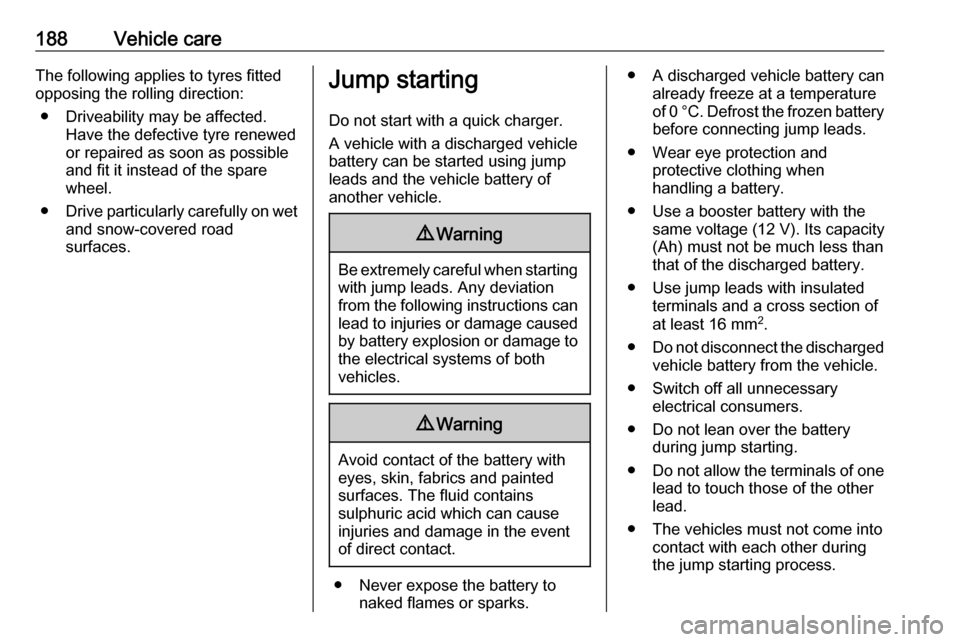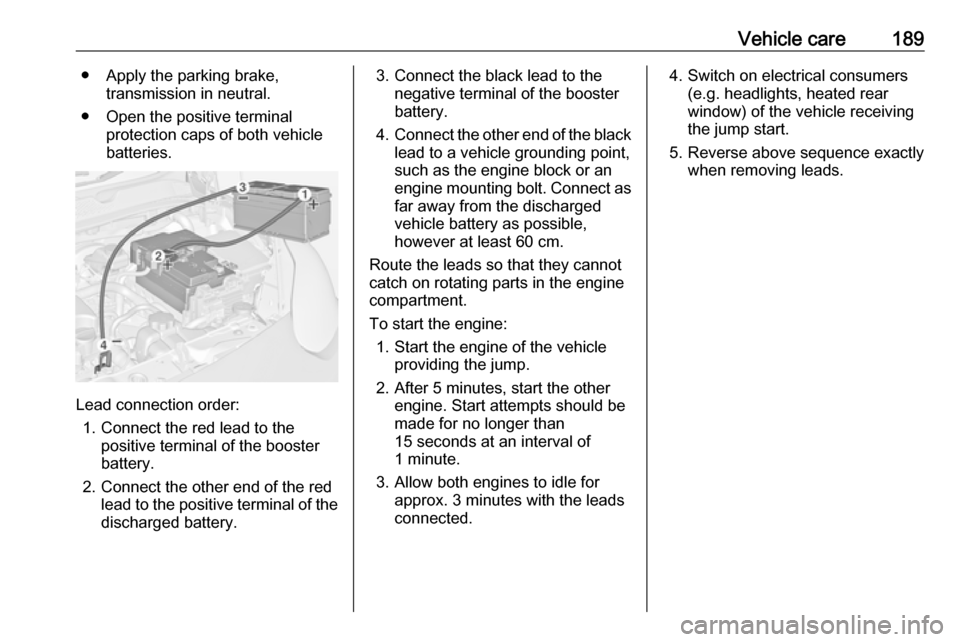battery VAUXHALL ADAM 2019 Owner's Guide
[x] Cancel search | Manufacturer: VAUXHALL, Model Year: 2019, Model line: ADAM, Model: VAUXHALL ADAM 2019Pages: 223, PDF Size: 6.54 MB
Page 168 of 223

166Vehicle careNo.Circuit1Rear carrier2Exterior mirror switch3Body control module4Foldable power sunroof5ABS6Daytime running light left / low
beam left7–8Power window switch9Vehicle battery sensor10Headlamp levelling / Ignition11Rear wiper12Window defog13Daytime running light right / low
beam right14Exterior mirror heating15–No.Circuit16Fuel pump module / LPG
module17Interior mirror / Voltage
converter18Engine control module19Fuel pump20–21Solenoid canister purge22–23Ignition coils / Injectors24Washer system25Ambient light sensor / Rain light sensor26Engine sensors27Engine management28Engine control module / LPG
module29Engine control module30–No.Circuit31Left highbeam32Right highbeam33Engine control module34Horn35Air conditioning compressor
clutch36–
Page 181 of 223

Vehicle care179
6.Unscrew valve cap from defective
tyre.
7. Screw the filler hose to the tyre valve.
8. The switch on the compressor must be set to J.
9. Connect the compressor plug to the power outlet or cigarette
lighter socket.
To avoid discharging the battery,
we recommend running the
engine.10. Set the rocker switch on the compressor to I. The tyre is filled
with sealant.
11. The compressor pressure gauge briefly indicates up to 6 bar whilstthe sealant bottle is emptying
(approx. 30 seconds). Then the
pressure starts to drop.
12. All of the sealant is pumped into the tyre. Then the tyre is inflated.
13. The prescribed tyre pressure should be obtained within 10 min.
Tyre pressure 3 206.
When the correct pressure is
obtained, switch off the
compressor.
If the prescribed tyre pressure is
not obtained within 10 min,
remove the tyre repair kit. Move
the vehicle one tyre rotation.
Reattach the tyre repair kit and
continue the filling procedure for
10 min. If the prescribed tyre
pressure is still not obtained, the
tyre is too badly damaged. Seek
the assistance of a workshop.
Drain excess tyre pressure with
the button over the pressure indicator.
Page 190 of 223

188Vehicle careThe following applies to tyres fitted
opposing the rolling direction:
● Driveability may be affected. Have the defective tyre renewed
or repaired as soon as possible
and fit it instead of the spare
wheel.
● Drive particularly carefully on wet
and snow-covered road
surfaces.Jump starting
Do not start with a quick charger.
A vehicle with a discharged vehicle
battery can be started using jump
leads and the vehicle battery of
another vehicle.9 Warning
Be extremely careful when starting
with jump leads. Any deviation
from the following instructions can
lead to injuries or damage caused
by battery explosion or damage to the electrical systems of both
vehicles.
9 Warning
Avoid contact of the battery with
eyes, skin, fabrics and painted
surfaces. The fluid contains
sulphuric acid which can cause
injuries and damage in the event
of direct contact.
● Never expose the battery to naked flames or sparks.
● A discharged vehicle battery canalready freeze at a temperature
of 0 °C. Defrost the frozen battery
before connecting jump leads.
● Wear eye protection and protective clothing when
handling a battery.
● Use a booster battery with the same voltage (12 V). Its capacity
(Ah) must not be much less than
that of the discharged battery.
● Use jump leads with insulated terminals and a cross section of
at least 16 mm 2
.
● Do not disconnect the discharged
vehicle battery from the vehicle.
● Switch off all unnecessary electrical consumers.
● Do not lean over the battery during jump starting.
● Do not allow the terminals of one
lead to touch those of the other
lead.
● The vehicles must not come into contact with each other during
the jump starting process.
Page 191 of 223

Vehicle care189● Apply the parking brake,transmission in neutral.
● Open the positive terminal protection caps of both vehicle
batteries.
Lead connection order:
1. Connect the red lead to the positive terminal of the booster
battery.
2. Connect the other end of the red lead to the positive terminal of the
discharged battery.
3. Connect the black lead to the negative terminal of the booster
battery.
4. Connect the other end of the black
lead to a vehicle grounding point,
such as the engine block or an
engine mounting bolt. Connect as far away from the discharged
vehicle battery as possible,
however at least 60 cm.
Route the leads so that they cannot
catch on rotating parts in the engine
compartment.
To start the engine: 1. Start the engine of the vehicle providing the jump.
2. After 5 minutes, start the other engine. Start attempts should be
made for no longer than
15 seconds at an interval of
1 minute.
3. Allow both engines to idle for approx. 3 minutes with the leads
connected.4. Switch on electrical consumers (e.g. headlights, heated rear
window) of the vehicle receiving
the jump start.
5. Reverse above sequence exactly when removing leads.
Page 215 of 223

Customer information213Operating data in the vehicleControl units process data for
operation of the vehicle.
This data includes, e.g.: ● vehicle status information (e.g. speed, movement delay, lateral
acceleration, wheel rotation rate,
"seat belts fastened" display)
● ambient conditions (e.g. temperature, rain sensor,
distance sensor)
As a rule such data is transient, not
stored for longer than an operational
cycle, and only processed on board
the vehicle itself. Control units often
include data storage (including the
vehicle key). This is used to allow
information to be documented
temporarily or permanently on vehicle
condition, component stress,
maintenance requirements and
technical events and errors.Depending on technical equipment
levels, the data stored is as follows:
● system component operating states (e.g. fill level, tyre
pressure, battery status)
● faults and defects in important system components (e.g. lights,brakes)
● system reactions in special driving situations (e.g. triggering
of an airbag, actuation of the
stability control systems)
● information on events damaging the vehicle
● for electric vehicles the amount of
charge in the high-voltage
battery, estimated range
In special cases (e.g. if the vehicle
has detected a malfunction), it may be
necessary to save data that would
otherwise just be volatile.
When you use services (e.g. repairs,
maintenance), the operating data
saved can be read together with the
vehicle identification number and
used where necessary. Staff working
for the service network ( e.g. garages,
manufacturers) or third parties (e.g.breakdown services) can read the
data from the vehicle. The same
applies to warranty work and quality
assurance measures.
Data is generally read via the OBD
(On-Board Diagnostics) port
prescribed by law in the vehicle. The operating datawhich is read out,
documents the technical condition of
the vehicle or individual components
and assists with fault diagnosis,
compliance with warranty obligations
and quality improvement. This data,
in particular information on
component stress, technical events,
operator errors and other faults, is
transmitted to the manufacturer
where appropriate, together with the
vehicle identification number. The
manufacturer is also subject to
product liability. The manufacturer
potentially also uses operating data
from vehicles for product recalls. This
data can also be used to check
customer warranty and guarantee
claims.
Fault memories in the vehicle can be
reset by a service company when
carrying out servicing or repairs or at
your request.
Page 218 of 223

216IndexAAccessories and vehicle modifications .......................... 148
Adjustable air vents ...................113
Airbag and belt tensioners ...........75
Airbag deactivation ................43, 75
Airbag label................................... 38 Airbag system .............................. 38
Air conditioning regular operation ................................ 114
Air conditioning system .............. 107
Air intake .................................... 114
Air vents...................................... 113
Antilock brake system ................ 123
Antilock brake system (ABS) .......77
Anti-theft locking system .............. 25
Appearance care ........................191
Ashtrays ....................................... 67
Automatic anti-dazzle ..................27
Automatic light control .................99
Automatic locking ........................23
Autostop ..................................... 118
B Battery discharge protection ......105
Battery voltage ............................. 89
Belts.............................................. 36
Bonnet ....................................... 150
Brake and clutch fluid .................196
Brake and clutch system .............76Brake assist ............................... 125
Brake fluid .................................. 153
Brakes ............................... 123, 153
Breakdown.................................. 190
Bulb replacement ....................... 155
C Capacities .................................. 205
Catalytic converter .....................122
Central locking system ................21
Changing tyre and wheel size ...176
Charging system .......................... 75
Child restraint installation locations ................................... 48
Child restraints.............................. 45
Child restraint systems ................45
Cigarette lighter ........................... 67
City mode ................................... 128
Climate control ............................. 15
Climate control systems .............106
Clock ............................................ 65
Code ............................................. 87
Control indicators.......................... 72
Control of the vehicle .................115
Controls ........................................ 61
Convex shape .............................. 26
Coolant and antifreeze ...............196
Cruise control ...................... 79, 129
Cupholders .................................. 51
Curtain airbag system .................. 43
Page 221 of 223

219Service information ....................195
Service vehicle soon .................... 76
Side airbag system ......................42
Side blind spot alert ....................141
Sidelights ...................................... 98
Side turn lights ........................... 162
Software acknowledgement .......210
Spare wheel ............................... 182
Speed limiter............................... 130
Speedometer ............................... 68
Starting and operating ................116
Starting off ................................... 16
Starting the engine ....................117
Steering ...................................... 116
Steering wheel adjustment ......9, 61
Steering wheel controls ...............61
Stop-start system........................ 118
Storage ......................................... 51
Storage compartments .................51
Sunroof ........................................ 29
Sun visors .................................... 29
Symbols ......................................... 4
T Tachometer ................................. 68
Tail lights ................................... 159
Three-point seat belt .................... 37
Tools .......................................... 169
Towing ........................................ 190
Towing the vehicle .....................190Traction Control system ............. 125
Transmission ............................... 16
Tread depth ............................... 175
Trip odometer .............................. 68
Turn lights ............................ 74, 101
Tyre chains ................................ 176
Tyre designations ......................171
Tyre pressure ............................ 171
Tyre pressure monitoring system ............................... 78, 172
Tyre pressures ........................... 206
Tyre repair kit ............................. 177
U Upholstery .................................. 194
Uplevel Display ............................. 80
Using this manual ..........................3
V Vehicle battery ........................... 153
Vehicle checks............................ 150
Vehicle data ................................ 200
Vehicle data recording and privacy ..................................... 212
Vehicle dimensions .................... 205
Vehicle Identification Number ....198
Vehicle jack ................................ 169
Vehicle messages .......................87
Vehicle personalisation ...............90
Vehicle security ............................ 25
Vehicle specific data ......................3Vehicle storage ........................... 149
Vehicle tools ............................... 169
Vehicle unlocking ........................... 6
Ventilation ................................... 106
W
Warning chimes ........................... 89
Warning lights ............................... 68
Warning triangle .......................... 57
Washer and wiper systems .........14
Washer fluid ............................... 152
Wheel changing .........................181
Wheel covers ............................. 176
Wheels and tyres .......................170
Windows ....................................... 27
Windscreen................................... 27
Windscreen wiper and washer ....62
Winter tyres ............................... 170
Wiper blade replacement ..........155